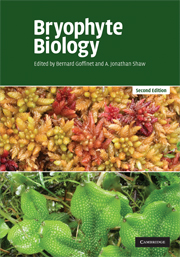Book contents
- Frontmatter
- Contents
- List of contributors
- Preface
- 1 Morphology and classification of the Marchantiophyta
- 2 Morphology, anatomy, and classification of the Bryophyta
- 3 New insights into morphology, anatomy, and systematics of hornworts
- 4 Phylogenomics and early land plant evolution
- 5 Mosses as model organisms for developmental, cellular, and molecular biology
- 6 Physiological ecology
- 7 Biochemical and molecular mechanisms of desiccation tolerance in bryophytes
- 8 Mineral nutrition and substratum ecology
- 9 The structure and function of bryophyte-dominated peatlands
- 10 Population and community ecology of bryophytes
- 11 Bryophyte species and speciation
- 12 Conservation biology of bryophytes
- Index
- References
5 - Mosses as model organisms for developmental, cellular, and molecular biology
Published online by Cambridge University Press: 06 July 2010
- Frontmatter
- Contents
- List of contributors
- Preface
- 1 Morphology and classification of the Marchantiophyta
- 2 Morphology, anatomy, and classification of the Bryophyta
- 3 New insights into morphology, anatomy, and systematics of hornworts
- 4 Phylogenomics and early land plant evolution
- 5 Mosses as model organisms for developmental, cellular, and molecular biology
- 6 Physiological ecology
- 7 Biochemical and molecular mechanisms of desiccation tolerance in bryophytes
- 8 Mineral nutrition and substratum ecology
- 9 The structure and function of bryophyte-dominated peatlands
- 10 Population and community ecology of bryophytes
- 11 Bryophyte species and speciation
- 12 Conservation biology of bryophytes
- Index
- References
Summary
Introduction
There is a popular genre of politically incorrect jokes on the theme of “The World's Shortest Books” (of which the least offensive example is the title “Different Ways to Spell Bob”). Until recently, it would have been fair to surmise that the title of this chapter might have qualified with ease. Certainly, that would have been the view of many soi-disant “mainstream” plant developmental biologists, whose Arabidocentric view of the plant kingdom had tended to ignore any organism outside the angiosperms (and most within). Thankfully, this is no longer the case. It is now appreciated that an understanding of the evolution of gene function and of the roles of genes in the programming of developmental transitions (generically known as “Evo-Devo”) requires a comparative analysis of species representative of a wide range of diverse taxa. This has coincided with an explosion of molecular knowledge of at least one species of moss, Physcomitrella patens, the study of which is being facilitated by the complete sequencing of its genome. Consequently, we can expect to see a much greater interest in this species, and in mosses as a group of plants with their own unique features and fascination, developing within the wider plant science community. In this chapter I shall therefore concentrate on the recent discoveries made in Physcomitrella, and – more importantly – attempt to sketch out some of the challenges that lie ahead for researchers intending to make use of the burgeoning Physcomitrella resources.
- Type
- Chapter
- Information
- Bryophyte Biology , pp. 199 - 236Publisher: Cambridge University PressPrint publication year: 2008
References
- 5
- Cited by



